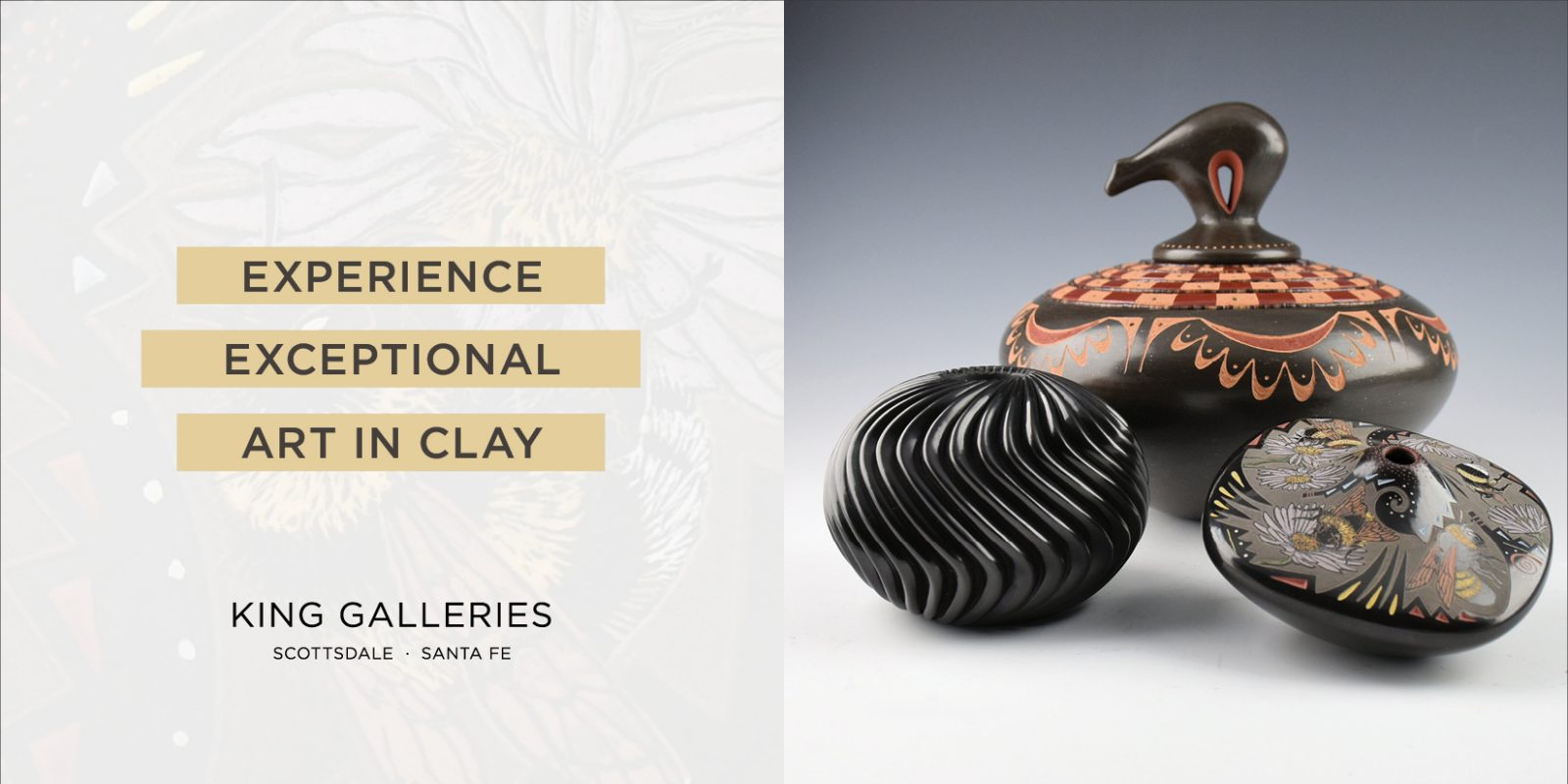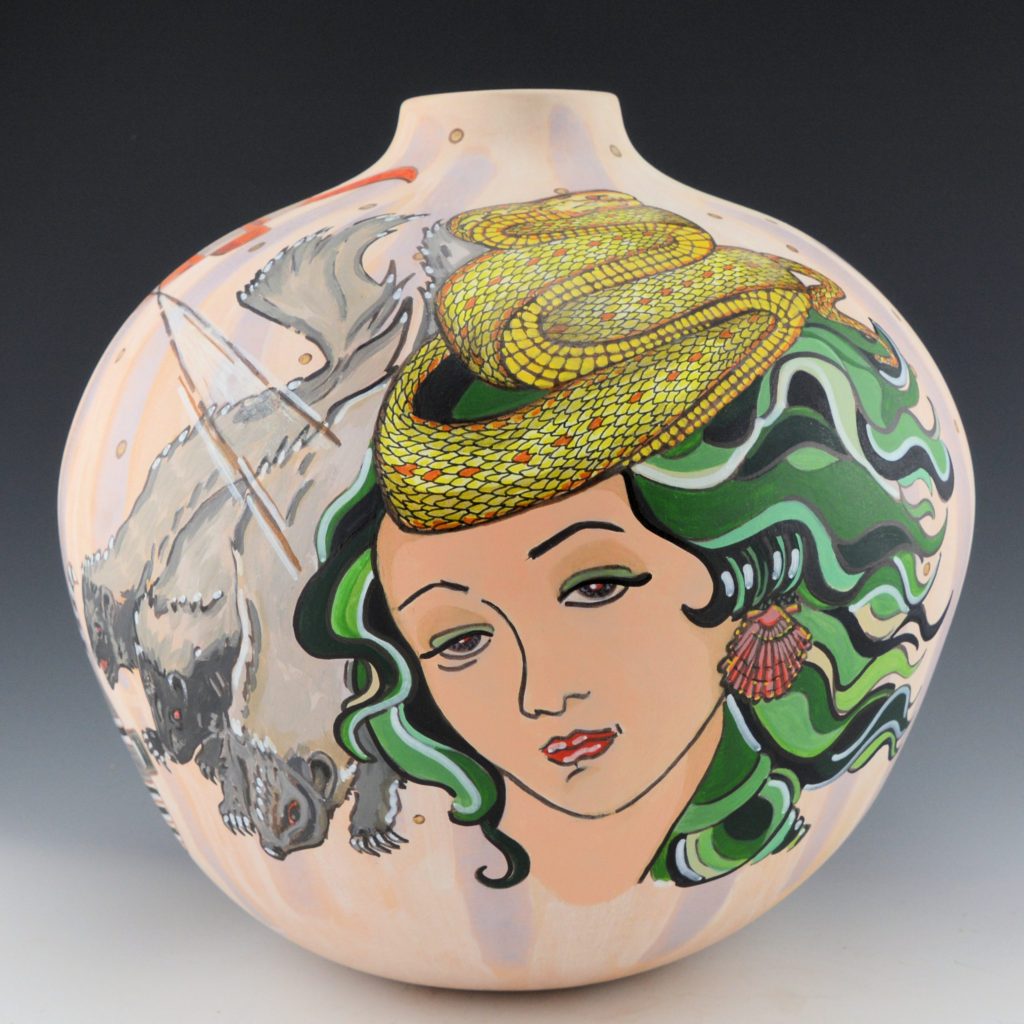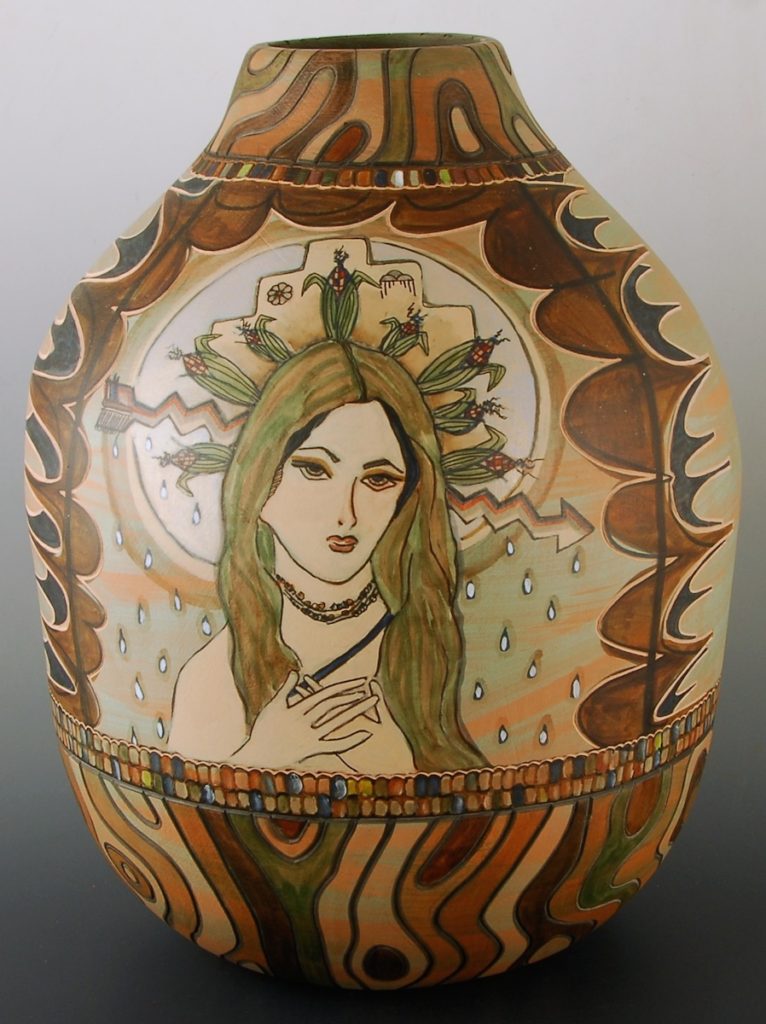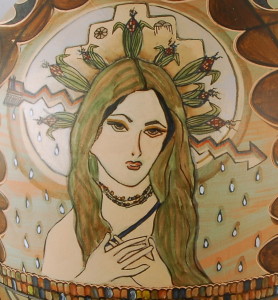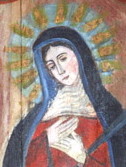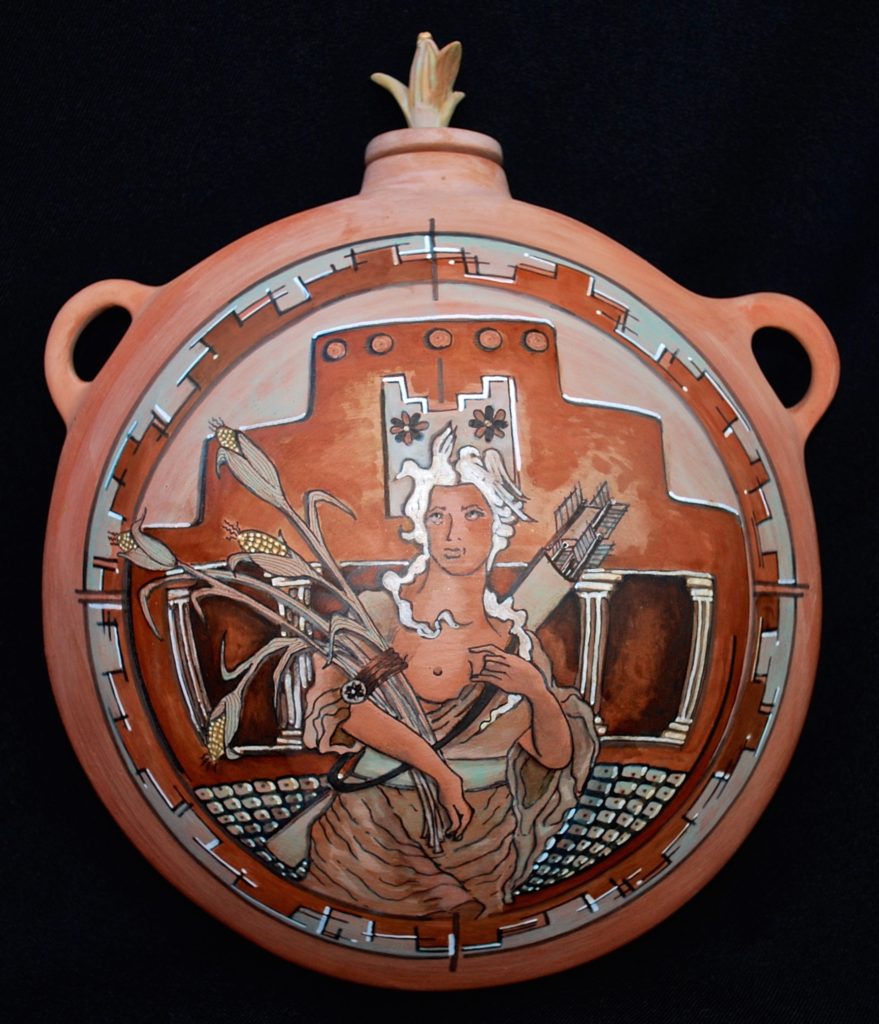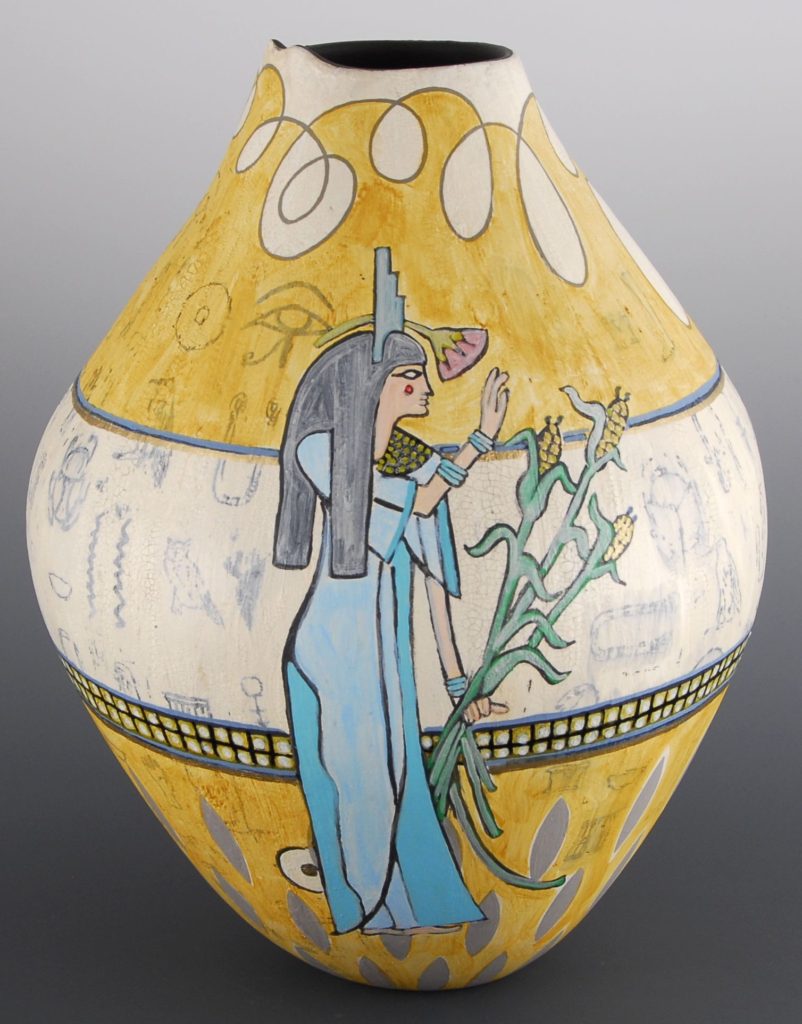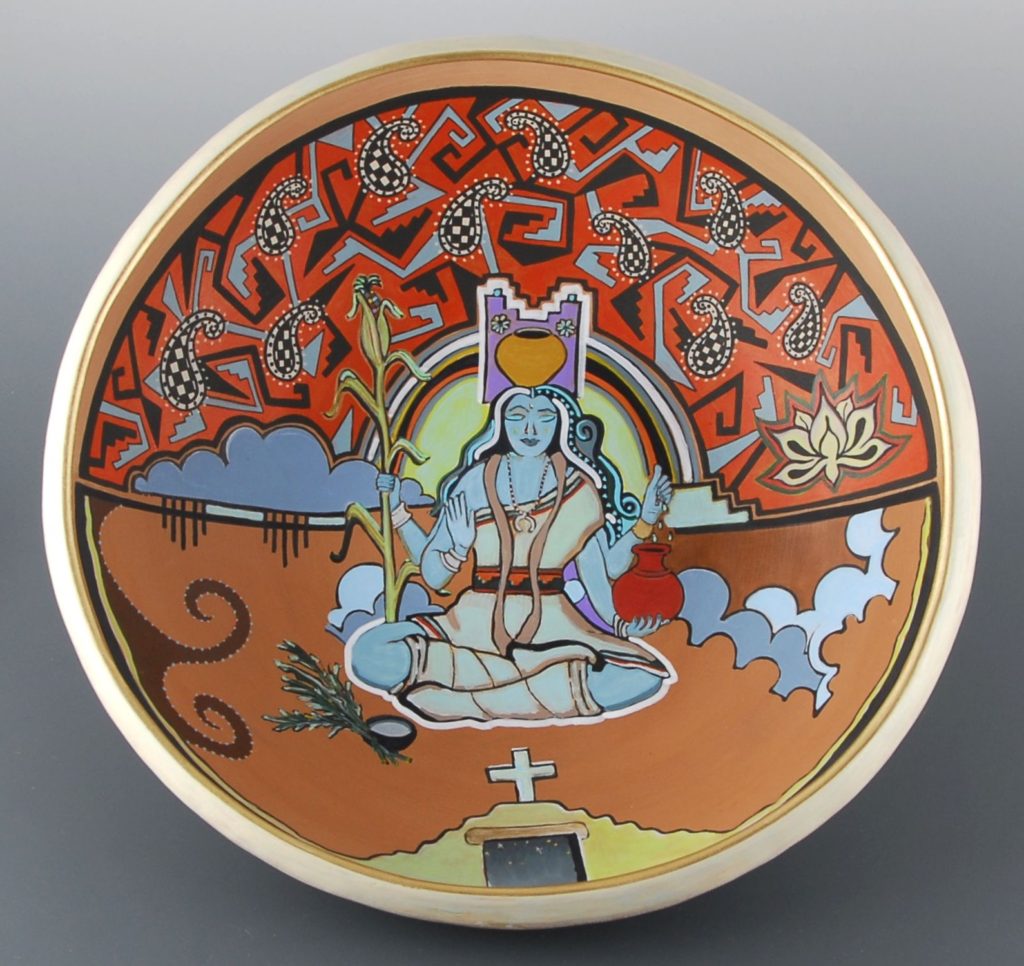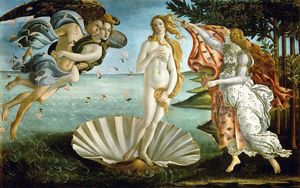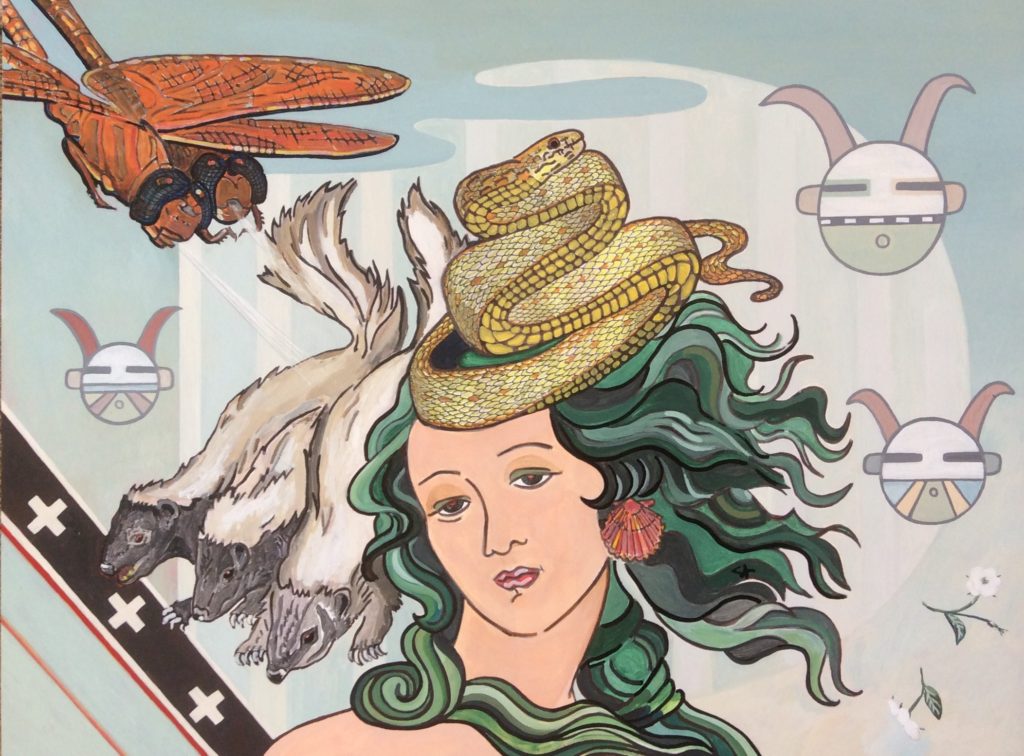Collector's Corner
FERTILE MINDS: Susan Folwell and Les Namingha’s Corn Maiden Series
Drawing from a seemingly endless well of creativity, Susan Folwell and Les Namingha are two of the most exciting and innovative contemporary American artists. Their predominant medium is ceramics, which they use much like a painter employs canvas or a sculptor stone or wood. Folwell is constantly pushing this art form in new directions – narrative, political, satiric, erotic, spiritual. While she is not afraid to tackle subjects as diverse as the Iraq War, the AIDS Crisis, Pueblo politics, Indian gaming, romantic and erotic love, personal loss, and the beauty of the natural world, many of her works are formal explorations of color and form, and her imagery ranges from the representational to the abstract and sometimes a combination of the two. Namingha, as well, endlessly explores the potential of the ceramic medium, blending the traditional and the contemporary in a variety of ways such as sometimes decorating his hand-coiled pots of Native clay with acrylic paints. At other times, Mr. Namingha will use Native paints but create an unusual form. His work is an investigation of color, form, and composition. The designs he employs are unique, highly detailed and precisely painted. Sometimes they are contemporary interpretations of early Zuni iconography but at other times clearly show the influence of Twentieth Century Modernism. It was inevitable that these two important contemporary artists would eventually collaborate.
Recently, Ms. Folwell moved in a decidedly new direction when she began the Corn Maiden Series. The spiritual beings called Corn Maidens are integral to Pueblo ceremonial life. For Native peoples throughout the Americas, corn is synonymous with life, fertility, and abundance. Along with beans and squash, corn is considered a gift of the Creator and together they are known as the Three Sisters. Each of the Corn Maidens represents one of the seven types of corn cultivated by the pueblos and all, except one, relate to a direction. Blue Corn Maiden, considered the most beautiful, was associated with north; Yellow Corn Maiden with the west; Red Corn Maiden with the south; White Corn Maiden with east; Multi-Colored Corn Maiden with above; Black Corn Maiden with below; and Dwarf Corn Maiden, who was not connected to any direction. The Corn Maidens are the female equivalent of the katsinas and, as such, are sacred beings.
In a recent interview, I asked Ms. Folwell what inspired her to create the works in the Corn Maiden Series. “The easy answer,” she stated, “would be to say it started last year, stumbling across photos on the Internet of different culture’s idea of the ultimate mother giver/replenisher throughout the centuries. But I think it began much earlier than that when I started my female superhero work (coming off of the Cry Baby Series) and slowly morphed the love of incorporating strong women into the design but then eventually incorporating the ultimate woman.”
Corn Maiden jar by Susan Folwell, Santa Clara Pueblo, Native clay, underglaze Native clay slips, and indigo inks, 8”w x 12”h (2014).
In her own unique way, Susan Folwell has chosen to portray the Corn Maidens in an undeniably non-traditional manner, blending elements of Pueblo, Spanish Colonial and Renaissance art. Often in Folwell’s, work form conveys meaning. One of the most important pieces in the series is a large jar. Its scale implies the significance of the Corn Maidens while the soft, rounded shape suggests a pregnant female form, once again symbolic of life and fertility.
Detail of Corn Maiden jar by Susan Folwell.
The two Corn Maiden images on the jar reinterpret visual elements that are associated with the Virgin Mary. In an exquisite use of line, the delicately drawn hands and soft features of the Corn Maidens resemble Madonnas by Raphael, Leonardo Da Vince, and other Renaissance masters.
Detail of the retablo of Nuestra Señora de Dolores at Santa Cruz de la Cañada Mission, Santa Cruz, NM.
The tilt of the head and the placement of the hands are also reminiscent of Spanish Colonial retablos, religious paintings on wood. The artist reinforces this motif with the jar’s coloration, which was designed to resemble aged wood.
In Ms. Folwell’s interpretation, the beams of light that usually surround the Virgin here become ears of corn, suggesting that the Corn Maidens are as significant in Pueblo’s religious belief as Mary is to Catholics. It is also a subtle reminder of the complicated and often difficult relationship between Native people and Christianity.
The halo of the Corn Maidens is presented as a tablita, a headdress worn by females as part of various Pueblo ceremonies. Shaped like a pueblo building, it bears the images of a cornflower and a rain cloud while below is a lightning bolt, in the form of an arrow, from which rain pours down. The Corn Maidens also wear corn kernel necklaces and below them are carved and painted bands of multi-colored kernels. Each of these characteristics is symbolic of the relevance of corn to Pueblo life. As wheat was to the Old World, corn was to the New World – without it life would have been difficult if not impossible.
Corn Maiden canteen by Susan Folwell, Santa Clara Pueblo, Native clay, 10” diameter x 4” (2014).
The artist reinforces the metaphor of women as sacred vessels in her Corn Maiden canteen. This iconic shape is rife with symbolic meaning since it, too, resembles an expectant mother and the form’s original purpose was to carry life-giving water. For thousands of years, corn has been connected with the fertility of women among Native Americans. Ms. Folwell has returned to the canteen form on numerous occasions for a variety of artistic purposes: satire, humor and for sheer visual beauty. However, it takes on added significance in the Corn Maiden Series. The canteen is a blending of motifs and cultures. The Corn Maiden stands before a building that is a mix of Pueblo and Greek architecture while behind her are corn kernels that appear as if they are cobblestones. Baring one breast, she wears a Pueblo headdress and her hair takes the form of doves. She carries corn stalks as well as a quiver filled with arrows. The mouth of the canteen has a stopper in the form of an ear of corn.
Ms. Folwell and Les Namingha had talked about doing a collaboration for many years. According to Folwell, “Continuing with the corn maiden series with Les seemed like a good thing to do as Les found the subject fascinating as well.” The two artists joined forces for the first time on a series of vessels for a show at the King Galleries of Scottsdale entitled “Corn:Maiden: Cultures”. The underlying idea for the exhibition is that the Corn Maiden of Pueblo culture is a primal universal female archetype. These pieces push Ms. Folwell’s original concept to another level imagining the Pueblo Corn Maiden in a variety of cultural settings. According to Mr. Namingha, the idea for the collaboration came from Folwell. “For several years, we both had a desire to collaborate on several pieces,” Namingha stated in an Email interview, “but . . . the opportunity never came. However, after a recent contact with Susan and a well-timed opportunity created by Charles King, we decided to work together to create a small body of work . . . . The theme was presented by Susan to produce works highlighting the Corn Maiden icon on display within the context of various cultural settings outside of the usual Pueblo context. As I reflected on my part in this interaction with Susan, I felt that my role would be one which is similar to Pueblo corn maiden dances or corn grinding ceremonies. As a male, I would be the one that provided the ‘music’ for the dance.” Mr. Namingha went on to say that he and Ms. Folwell discussed the pieces they were to work on and that Folwell explained which cultures would be used as the inspiration for each maiden. “In reference to my role as a musician,” Mr. Namingha added, “we discussed how this collaboration was like being part of a band. Susan was to be the lead singer and soloist, and I would provide the rhythm and the beat! And so, that is how we moved forward in our work. Much of my painting involved focusing on the underpainting and texture and color of the jars. Susan’s paintings of the corn maidens, as well as added imagery, provided the focus of the narrative and bonded the rhythm and lead together. We both provided the structure and shape of the jars.”
Corn Maiden: Seeds of the Earth by Susan Folwell (Santa Clara) and Les Namingha (Hopi-Tewa/Zuni), 7.5″W X 10.25” H (2015).
One of their most interesting pieces in the series is Corn Maiden: Seeds of the Earth. The tall, textured jar was made by Folwell who also painted its central section with its hieroglyphs. Mr. Namingha painted the top and bottom. Resembling images in an ancient tomb, the Egyptian-style corn maiden carries corn stalks and wears a Pueblo headdress and a lotus, symbol of creation, rebirth, and regeneration.
Lakshmi open bowl by Susan Folwell (Santa Clara) and Les Namingha (Hopi-Tewa/Zuni), 12.5″W X 3.25” H (2015).
In Lakshmi, an open bowl by Fowell and Namingha, the artists place the corn maiden in a Hindu incarnation. Curiously, Lakshmi is painted blue, something never seen in Hindu representations of her. About this, Ms. Folwell stated, “The color blue for Lakshmi seemed natural as she isn’t quite mortal but still a giver on the mortal plane . . . .” The goddess also wears a Pueblo headdress decorated with the image of a ceramic pot and two corn flowers as well as a Pueblo tunic, belt, and leggings. She also wears a necklace with a naja, a crescent shape design of Moorish origin that came to the Southwest via the Spanish. Lakshmi holds a corn stalk and a ceramic pot while water emanates from one of her four hands. She hovers in the clouds above a Pueblo church, seated in the meditative cross-legged lotus position. Near her are evergreen branches and a bowl of water. According to Ms. Folwell, “They are used to sprinkle ‘holy’ water for blessings.” Behind the goddess are Pueblo designs as well as the image of a lotus, a flower associated with Lakshmi since it is a symbol of beauty, fertility, prosperity, and spirituality. There is also a paisley design incorporated into the background. Known as mankolam, it is modeled after the mango, a sweet fruit that symbolizes fulfillment and good fortune. The central figure of the piece was painted by Ms. Folwell while the surrounding patterns were created by Mr. Namingha.
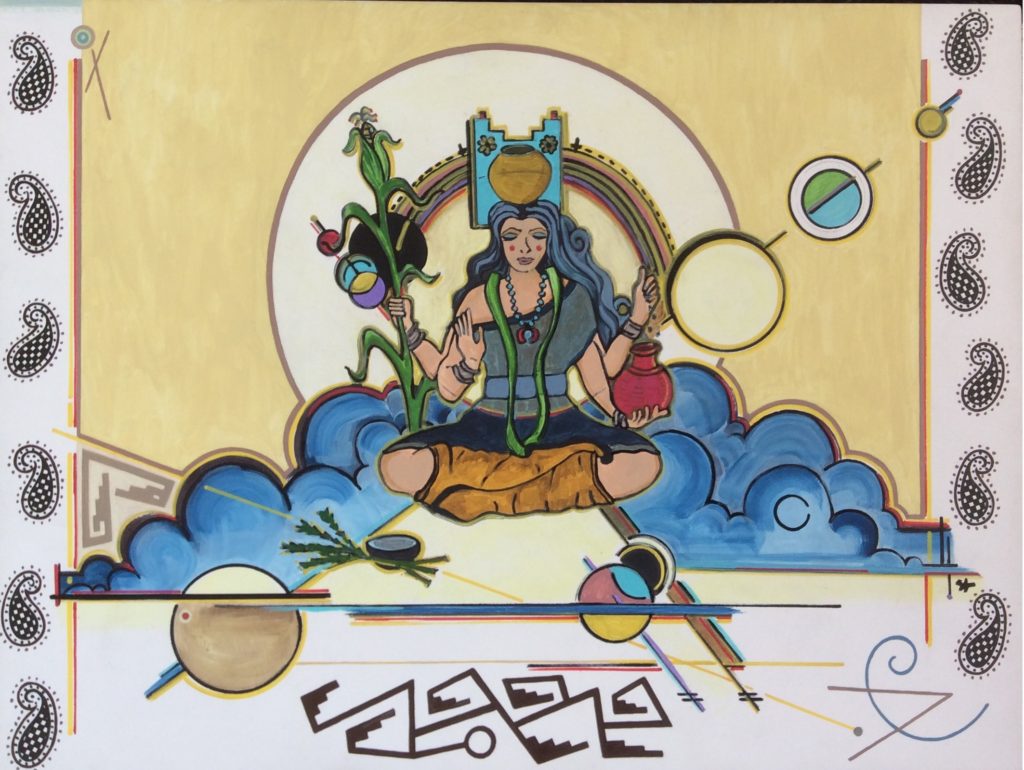
Lakshmi by Susan Folwell (Santa Clara) and Les Namingha (Hopi-Tewa/Zuni), acrylic on canvas, 12” X 16” (2015).
In addition to ceramic works, Susan Folwell and Les Namingha also created two paintings for the Corn Maiden Series. One is a re-interpretation of the motifs employed in Lakshmi, the open bowl the artists produced. Because the artists were now working on a flat canvas rather than a three-dimensional concave surface, certain design elements were changed or re-arranged. As with the bowl, the goddess remains the focal point. She still hovers in the clouds, holding the same symbolic objects but there is no Pueblo church below. Instead, Lakshmi sits in the lotus posture amid orbs, reminiscent of the work of Russian abstract artist Wassily Kandinsky whom Folwell has referenced in earlier works. The central image is bordered at the bottom by a Pueblo stepped pattern that, according to Mr. Namingha “represents power and blessings from heaven in the form of rain clouds/lightning” and on the right and left by the traditional Hindu mankolam or paisley pattern. Once again, the figure was painted by Ms. Folwell while the surrounding imagery was created by Mr. Namingha.
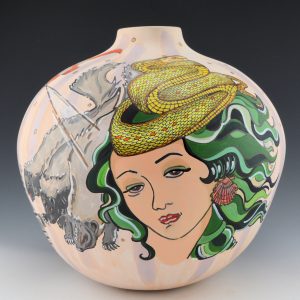 |
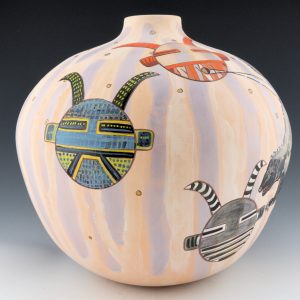 |
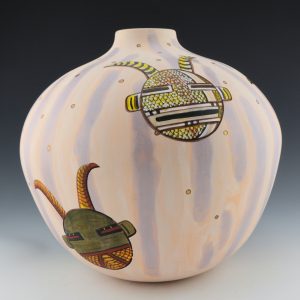 |
Birth of the Corn Maiden by Susan Folwell (Santa Clara) and Les Namingha (Hopi-Tewa/Zuni), 10“W X 10” H (2015).
With Birth of the Corn Maiden, the artists turned to Renaissance Italy, drawing inspiration from Sandro Botticelli’s The Birth of Venus. One of the period’s most famous works, the painting portrays the goddess standing on a shell as she rises from the sea fully formed at birth. To the left of Venus floats Zephyrus, God of the Winds, his left arm supporting the gentle breeze Aura. Together, they blow the Goddess of Love ashore where a Horae, one of the Goddesses of the Seasons, holds out a flower-covered robe with which to cover the nude Venus.
The Birth of Venus (Nascita di Vere) by Sandro Botticelli, tempera on canvas, 67.9” x 109.6” (c. 1486), Uffizi Gallery, Florence, Italy.
In The Birth of the Corn Maiden, Ms. Fowell and Mr. Namngha’s creation, the central figure’s face is clearly influenced by the Botticelli painting. This debt is slyly acknowledged through the Corn Maiden’s shell earring. Here the
goddess bears a corn snake on her head, her hair suggestive of corn leaves. To the left are three badgers as well as two katsina heads, which similar to Zephyrus, blow the breath of life towards the Corn Maiden. According to Ms. Folwell, “The imagery I chose was my two clans as well as the one to which Les belongs. The badger clan is my grandfather and corn is my grandmother’s. Les’ family is also corn clan, hence the corn snake.” The jar was made by Mr. Namingha and painted by both artists.
Birth of the Corn Maiden by Susan Folwell (Santa Clara) and Les Namingha (Hopi-Tewa/Zuni), acrylic on canvas, 12” X 16 (2015). Collection of E. J. Guarino
As with Lakshmi, Ms. Folwell and Mr. Namingha created a ceramic work and a painting titled Birth of the Corn Maiden. Once again, because the artists were now working on a flat service rather than a three-dimensional piece, certain visual elements were changed. The Corn Maiden, wearing her iconic corn snake, remains the work’s focal point and the three badgers remain. However, asked about the two paintings she and Mr. Namingha created for the “Corn:Maiden: Cultures” exhibition at King Galleries, Ms. Fowell said, “I didn’t do rough draft drawings for them; I just had pictures for inspiration. Les Namingha encouraged me to do a couple of paintings with him after the images were set to clay. That was a lot of fun and I’d like to continue that for the future. The katsina faces are now passive rather than active. Two large dragonflies have been added to the overall design and it is they, not the katsinas, whose breath blows towards the goddess. Associated with healing and transformation, dragonflies are considered so sacred among the Pueblos that killing one is taboo. Two other components were also added: a band with three Pueblo crosses, symbolic of the sacred number four, on the lower left of the painting and corn flowers on the lower right.
Casino Corn Maiden plate by Susan Folwell (Santa Clara), 8.5 diameter X 1.5”H (2015).
Susan Folwell has often created works that comment on social and political issues, including the controversy surrounding Indian casinos. With her Casino Corn Maiden plate, Ms. Folwell once again tackles the thorny subject of gaming establishments on Native lands. Although gambling is considered problematic by many Native Americans, casinos do bring in large sums of money, which are used for education, cultural institutions, and health initiatives. “How could the casino not be represented,” Ms. Folwell stated. “While the Corn Maiden may apply to food,” she added, “it is also the giving to and from the casino!” The plate’s block carved rim adds to its wonderful shape. The image of the Corn Maiden is done in the style of Spanish retablos with ears of corn and an arrow replacing the halo, the circular ring of light that surrounds images of Christian religious figures. Here the Corn Maiden also wears a tablita and a necklace of corn kernels. She is surrounded by playing cards on the front rim of the plate and on the reverse there are Casino Corn Maiden coins. Ms. Folwell made the plate and painted it as well.
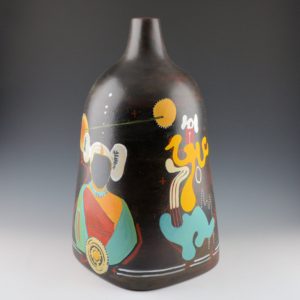
Corn Maiden: Earth Mother jar by Susan Folwell (Santa Clara) and Les Naming (Hopi-Tewa/Zuni), 8.25 W X 15” H (2015).
At fifteen inches in height, Corn Maiden: Earth Mother is spectacularly large for a ceramic work. Artists are often reluctant to create such big pieces because they have a tendency to explode during the firing process, something that did not deter Mr. Namingha. Corn Maiden: Earth Mother makes a powerful statement not only due to its size but, perhaps more importantly, because of the imagery on the jar’s four panels. On two sides, Ms. Fowell painted a Hopi maiden and a Pueblo maiden, leaving the faces blank so that they symbolize all women. These figures reference the Pueblo and Hopi ancestry of the two artists. In counterpoint to Ms. Folwell’s representational portrayals, Mr. Namingha created abstract versions of the maidens on the vessel’s other two sides.
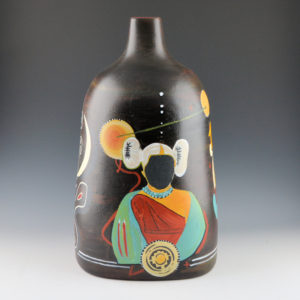 |
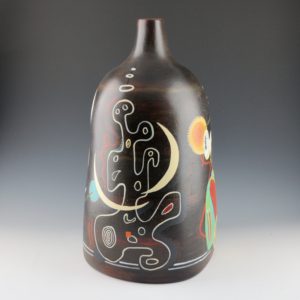 |
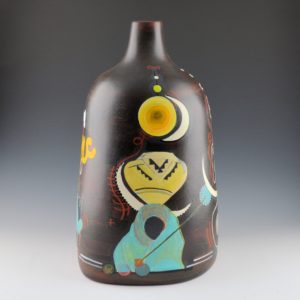 |
Corn Maiden: Earth Maiden jar by Susan Folwell and Les Namingha (alternate views).
Corn Maiden: Earth Mother is a particularly brilliant collaboration, bringing together themes of universal womanhood, tradition, modernism, and ancestry. The piece is also an exploration of color, form and composition, a hallmark of both artist’s work
Corn Maiden tile by Les Namingha (Hopi-Tewa/Zuni), 5.25 X 6.5” (2015).
Continuing with the Corn Maiden Series, Mr. Namingha created Corn Maiden, a contemporary ceramic tile that harkens back to old Hopi-Tewa tiles. The piece bears a traditional image of a corn maiden and its painted, textured surface creates the impression that it is a historic, rather than modern, work.
The Corn Maiden Series is an important undertaking for both Susan Folwell and Les Namingha. Ask what they had hoped to achieve with this series, each artist had a unique response. “I’m not sure that I plan to accomplish any one thing with this series,” Folwell stated, “because I don’t see an end to it. I think it’ll find a natural metamorphosis into something else as well although I have no clue as of yet what that would be.” Mr. Namingha said that he felt it would be up to Ms. Folwell to answer as to where she wants the series to progress but added, “I think for both of us, we have accomplished sending out a prayer and a song for the gratitude of life.” He went on to say, “We have not talked about continuing the Corn Maiden Series, but I think it would be possible to continue, sure. There were other ideas and cultural settings that we discussed but did not have time to finalize. However, I do know that we have plans to collaborate with other themes in mind.” As for producing solo works based on the Corn Maiden theme, Mr. Namingha stated, “I will, from time to time, focus on corn maiden imagery since they are an integral part of the Nampeyo family theme as it relates to pottery design; they being corn clan, and I being a child of.” In whatever direction these two amazing artists choose go collectors can be assured that the work they create will be innovative, exciting and thought-provoking.
